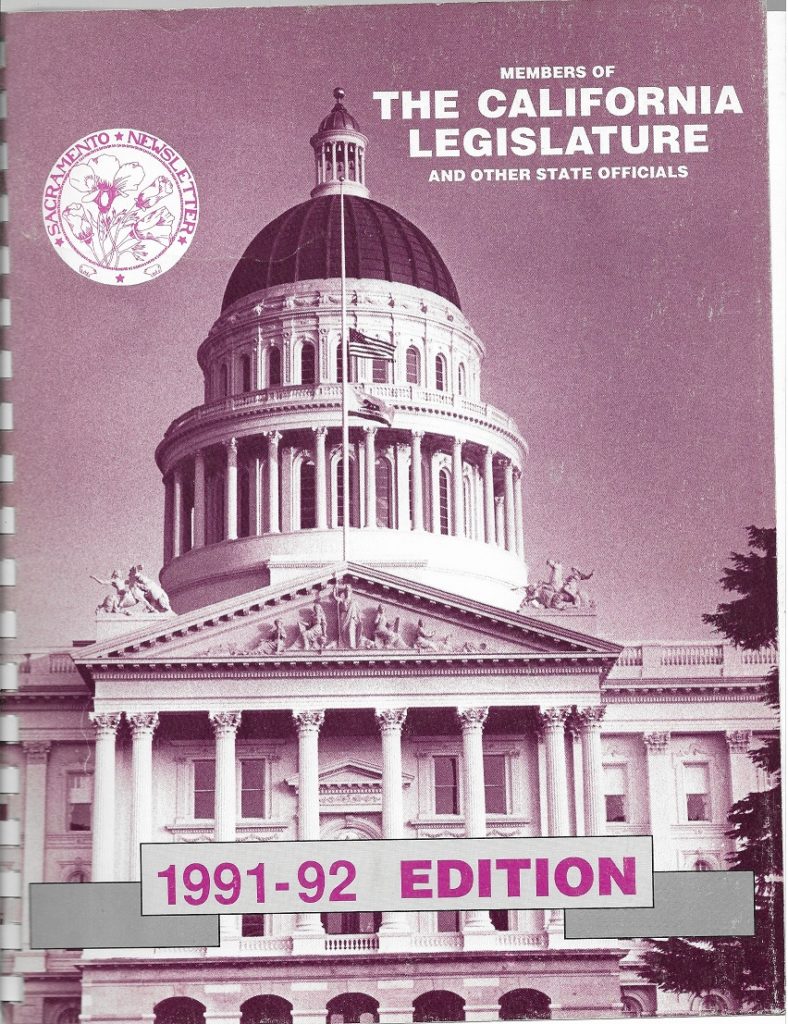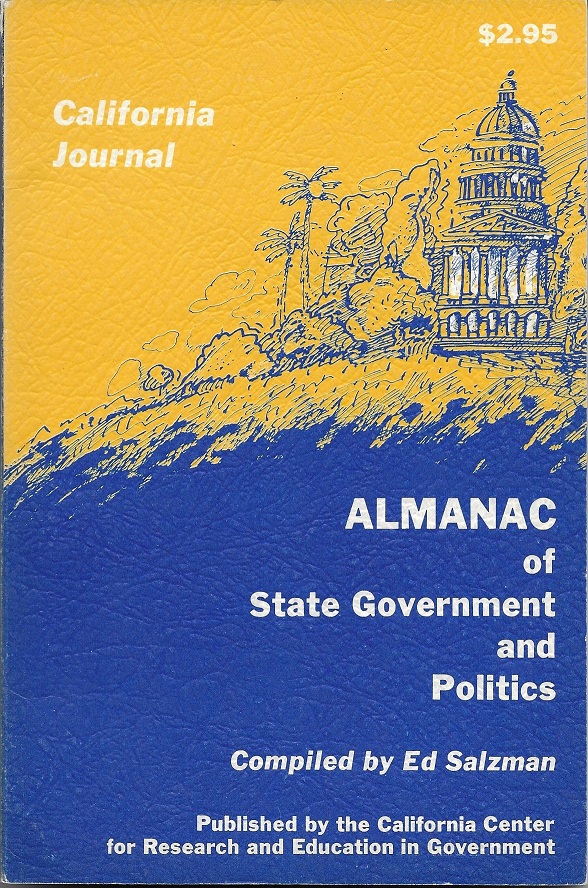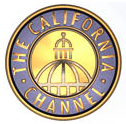Over the years, there have been a variety of ways for Sacramento insiders and California citizens at large to learn about what’s happening in the Capitol. Although not comprehensive, below is a list that excludes regular coverage in newspapers and trade-specific publications.
Story of the Legislature (1906-1939)
Franklin Hichborn, a reporter for the Sacramento Union, wrote a series of books chronicling the rise and fall of the anti-Railroad forces during California’s Progressive Era. Sharing his insights through public addresses and books (for example “The Story of the California Legislature of 1909”) there have been very few books which detailed how specific legislators voted on key bills each session. In the 1950s, Hichborn published a 2,861-page six-volume series titled “California Politics, 1891-1939” describing his experiences similar insights.
Scanned copies of the book available at Archive.org; 1909, 1911, 1913, 1915, 1921.
Sacramento Report (1947-1995)
Initially named the “McBride-Booe Sacramento Newsletter” (until1950), the newsletter was the longtime project by husband and wife Floyd and Agnes Booe. Floyd Booe had served as the secretary for the Northern California Chapter of the Associated General Contractors.
Copies are available in the California History Room at the California State Library
Assembly Office of Research (1968-1994), Senate Office of Research (1969-Present)
Established in the late 1960s by each house of the legislature, the Assembly and Senate Offices of Research were nonpartisan offices providing research services to legislators and committees. The Assembly Office of Research was abolished due to budgetary limitations resulting from Prop 140, while the Senate Office of Research continues to exist today.
Website at Senate Office of Research
California Journal (1970-2005)
The undisputed heavyweight in the arena was the California Journal, a monthly publication that presented current issues and interviews with officeholders. Described as “the authoritative Sacramento-based monthly that specializes in reporting and analyzing the state’s political scene” the Journal conducted annual rankings of legislators on a number of characteristics (some flattering, some not).
Archived at https://www.unz.com/print/CalJournal/Contents/
Almanac of State Government and Politics (1975-1984)
The Almanac of State Government and Politics was compiled by Ed Salzman and published by the California Journal in 1975, 1977, 1979, and 1983.
California Government and Politics Annual (1979-2005)
Starting in 1979, Ed Salzman (who was continuing to compile the similarly-named “Almanac of State Government and Politics” also started collaborating with Thomas R. Hoeber and Charles Price to produce the California Government and Politics Annual which was also published by California Journal Press. Editions were printed in 1979, ????, and 1991 through 2005.
Capitol Weekly (1988-Present)
Operated initially as a print publication, Capitol Weekly served for decades as the “hometown newspaper” of the State Capitol. In addition to covering the happenings in the Building, a favorite feature was the editions that included the state’s payroll data (with details on how much each state employee earned). Capitol Weekly’s print edition ended in 2012, the same year that it became a part of the nonprofit Open California. Since 2012, Capitol Weekly has been an online publication featuring articles, podcasts, television shows on “Cal Channel” and a series of events focused on Public Policy.
Online at https://capitolweekly.net/
California Political Almanac (1989-2000)
For a decade, Dan Walters chronicled the personalities and happenings of the Capitol in a series of books for each session. Books were titled for each two year session (1989-90, 1991-92, etc.) and covered the end of the Willie Brown era in Sacramento as well as the transition to a term-limited legislature.
California Target Book (1993-Present)
Established in 1993, the California Target Book gives non-partisan, unbiased information to all who want to be kept fully informed and up-to-date on congressional and state legislative election campaigns in California. The online edition includes a comprehensive set of tools for keeping up-to-date on every aspect of California’s political system.
Website is California Targetbook
The California Channel “Cal Channel” (1993-2019)
“The California Channel was a public service network television channel funded entirely by California’s cable television operators from 1993-2019. The network was a means to provide Californians with direct access to “gavel-to-gavel” proceedings of the California Legislature and other public policy forums, as well as a balanced presentation of viewpoints.”
The Cal Channel collection can today be found at the California State Archives
Public Policy Institute of California (1994-Present)
Although not designed solely as a tool to help the public understand their state and government, the PPIC provides important both expert analysis of complicated public policy issues as well as both conferences and presentations on topics relevant to people interested in learning about the issues facing California policymakers (as well the public’s perceptions of how well those policies are working). For decades, PPIC reports have often served as the “waiting room magazines” for visitors to legislative offices who have a few minutes before their meeting begins.
Online at https://www.ppic.org/
Capitol Morning Report (1994-Present)
Founded by longtime Los Angeles Times bureau chief (and also editor of the California Journal) Robert Fairbanks, the Morning Report provides the Capitol community with the days events (and a preview of things to come) in bite-sized pieces for consumption on the run. In the years since it started, the operation has shifted from fax service to email and finally to a website in 2006.
the CMR to subscribers through facsimile. Either at the beginning or soon after the beginning, dad started emailing the CMR as a Microsoft Word or Corel WordPerfect attachment. The WordPerfect crowd wasn’t very big and around 1998 or 1999 we started distributing by fax and by Word only. Around 2000 we converted the CMR to .pdf. I can’t remember when we stopped faxing and only distributed by email. When we put it online in August of 2006 we stopped emailing. Today, the enterprise is run by the second generation, with John Fairbanks having taken the reigns several years ago.
Online at https://capitolmr.com/
The Round-up (1995-2009) and The Nooner (2009-2021)
For more than twenty years, Scott Lay observed Sacramento politics and offered his thoughts, interpretations, and predictions freely* with his readers. His daily Nooner publication, arriving in email inboxes at about 12:05 pm each day, would offer commentary on the weather, the previous day’s news and rumors, and insight into what might be happening in the weeks ahead.
* Well, mostly freely. Subscriptions were available too.
Rough and Tumble (1998-present)
Rough and Tumble has long been the staple resource for college students taking classes in state government and those wanting to get a wider perspective on state politics than any one news source is likely to provide. Jack Kavanagh was a political reporter for nearly thirty years including as the political reporter for KOVR-TV for 17 years. He puts together a no-nonsense collection of news clips that are presented with minimal explanation or interpretation.
Online at Rough and Tumble
California Journal of Politics and Policy (2009-Present)
Institute of Governmental Studies (UC Berkeley)
An academic-oriented of policy issues facing California as well as retrospective analysis of California political history.
Online at https://escholarship.org/uc/cjpp/14/1
Capitol Alert by the Sacramento Bee (200?-Present)
Back in the day, even legislative staff (who you might expect to know what was happening) counted on Shane Goldmacher (and then Torey Van Oot) to deliver the news about what was happening down the hallway or behind closed doors. One of the recurring jokes in the LOB was to ask “Who has Torey Van Oot been talking do?” with everyone else is the room quickly shouting “Not me!” and pretending to flee the room.
In the years since, the Capitol Alert has continued to deliver important news as it breaks in the Capitol and around the neighborhood.
Capitol Alert
California Playbook (2017-present) and California Playbook PM by POLITICO (2021-present)
The POLITICO California team offering their insights and interpretations in a daily (or twice-daily) newsletter that’s as fun to read as it is informative. Initially as a project by David Siders and Carla Marinucci, the Jeremy B. White replaced Siders a year later and it would later become the Lara Korte and Dustin Gardiner Show during the Pandemic years.
The “PM” edition was launched in 2021 with Kevin Yamamura delivering the latest on what’s important.
California Playbook and California Playbook PM
WhatMatters by CalMatters (2019-Present)
CalMatters arrived on the scene in 2015 as a nonprofit news organization covering California state politics and policies. In 2019, the outlet gained the WhatMatters newsletter (occasionally called WhatHappened? by staff) which provided a daily summary of what the latest reporting was on. Written first by Dan Morain and later by Emily Hoeven (2020-2023) and Lynn La (2023-Present), the newsletter includes a good job trying to weave all the stories of the day into a single cohesive narrative.
WhatMatters – CalMatters
L.A. Times Politics newsletter (2021-Present)
After an initial start (2021-2024) as the California Politics newsletter hosted by John Myers (who would later depart to help keep a closer eye on my retirement), the newsletter got a shake-up and was renamed the L.A. Times Politics newsletter in early 2024.
L.A. Times Politics newsletter



